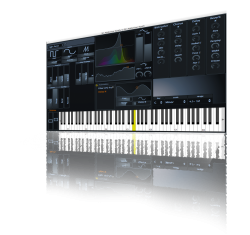Stagecraft Software recently released its newest VST, Addiction, a subtractive synthesizer “built to be simple and intuitive, but with the depth of any professional subtractive synth.”
Addiction has three fully configurable oscillators, an “incredible” spectrum display for the main filter, “killer” effects, and an advanced level of automation control.
 Synth designer Aaron Leese explains further:
Synth designer Aaron Leese explains further:
“The unique features here are a real time display of the filter response (with a spectrum overlay), and an automation suite that allows the user to apply LFOs to as many of the parameters as desired (all parameters can be quantized, so this can yield some very intricate and powerful results).
“This synth is designed to let you see exactly how a synth is built. When you alter any characteristic, you will clearly see how the audio is affected on the filter/spectrum display. Similarly, we’ve built out an automation suite that lets you apply an LFO to any of number of parameters, resulting in sounds and combinations you simply won’t find anywhere else.”
Pricing and Availability. Stagecraft’s Addiction synth is available as a free, thirty-day trial download, or as a full product key for $36 via the Stagecraft Software website.

Might be a great synth, but naming a SUBtractive synth “ADDiction” seems like a fail to me…
Agreed! Especially considering that Image-Line’s additive synth is called Morphine (as it morphs between additive profiles), and VirSyn’s additive synth is called “Addictive” And, a subtractive synth is …well… ubiquitous. They could have used that ubiquitous search engine to find out what is going on in the world of soft synths.
Rename it SUBiquitous!
how about SUB _MISSION
I hear some digital “cleanliness” in it, but there’s also some nice analog-y beef to be heard. I’m covered for subtractive, but I’ve heard synths aim for this spot and miss before, so Aaron did good work. The filter display is a nice touch. Even if you’re an analog obsessor, 4 or 5 like this and there’s not much left that you can’t do. Analog synths aren’t generally THAT different, so with a little care, you can cover a tonal spread like the classic Moog/ARP/Obie triad. (Yeah, the real thing amped up well has a hotter edge of its own, but its fair to compare their similar points.) If Aaron is going to update it on the fly for a while and add new patches, that’s a welcome touch not unlike Wolfgang Palm’s. Good starter WIN.